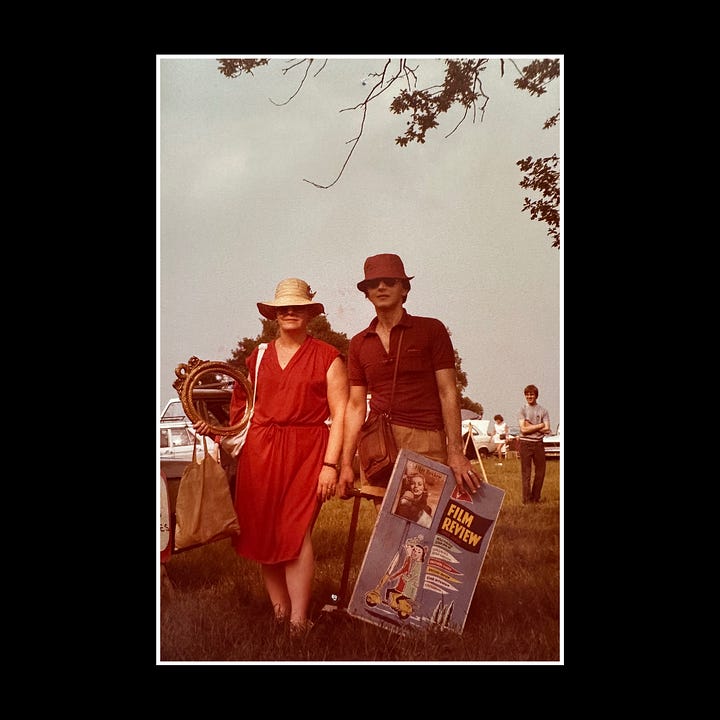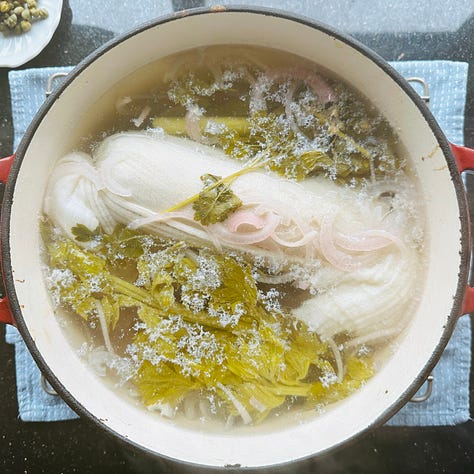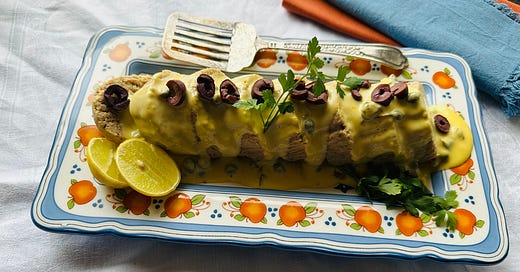Cooking with Marcella: A Journey Through Classic Italian Cooking
In 1984, while living in London, I was introduced to a cookbook that would become one of my most trusted kitchen companions—The Classic Italian Cookbook by Marcella Hazan. At the time, I was already deeply immersed in cooking, but Marcella’s approach was different from anything I had encountered before. Her voice was authoritative yet personal, guiding me not just through recipes but through the very essence of Italian home cooking. Over the years, I’ve cooked so many of her dishes that I no longer need to reference the book for many of them—they’ve become second nature, woven into the fabric of my own culinary repertoire.
This Substack, Cooking with Marcella, is my way of returning to those pages with fresh eyes. My goal is simple: to cook my way through Marcella Hazan’s books, following her recipes exactly as she wrote them, without any modifications or modern reinterpretations. Along the way, I’ll explore the regional and historical significance of each dish, highlight any differences between early and later editions of her books, and share insights into the techniques that define Italian cooking.
This is not just about following recipes—
it’s about understanding the wisdom behind them.


A London Kitchen, an Australian Artist, and an Italian Education
My introduction to Marcella Hazan’s cooking came in the most fitting of places: a small terrace home in Clapham Common, where I lived with a couple who embodied the very essence of Italophiles. Dallas, an Australian artist and family friend, spent her days in her studio, while her American husband Max—a spirited antique dealer—held command over the kitchen. Every evening, Dallas would drift downstairs, drink in hand, while Max finished the night’s dinner preparations. Their meals, without exception, were Italian, all prepared from The Classic Italian Cookbook.
Max had taught himself to cook using Marcella as his guide, and in turn, he became my teacher. Every night was a lesson. There was always a salad, followed by a risotto or pasta dish, and on weekends, something more elaborate—perhaps a loin of pork braised in milk (Arrosto di Maiale al Latte) or slow-baked tomatoes (Pomodori al Forno) alongside Milanese veal cutlets (Cotolette alla Milanese). Living with Max and Dallas was more than just a culinary education—it was a masterclass in how to live, how to think, how to read.
Books would appear on my bedside table, left for me by Dallas —The Female Eunuch was one of course and the poets and others, all chosen to provoke thought and conversation. Dinner discussions were lively, often politically charged, as this was the time of the 1980s miners’ strike, a period of deep unrest in the UK. They trained me in debate at the dinner table and over walks in Dallas’s lush rose garden. I still hear her voice: “Let’s go look at the garden,” she would say as I returned home from work, her joy as abundant there as in the food Max cooked each evening—meals crafted not just for sustenance, but for delight.
Eventually, I took up a nursing position and moved to North London, but Max and Dallas remained my family in the city. The time spent in their home, learning the rhythms of Italian cooking, shaped me in ways I could not have anticipated. And so, this project is a return—not just to Marcella’s recipes, but to the foundation they built in my own life.


Starting with Salame di Tonno
For my first post, I’m beginning with a dish that has quietly evolved over the years. Originally titled Salame di Tonno (Tuna Salami) in The Classic Italian Cookbook, this elegant yet humble recipe later appeared in Essentials of Classic Italian Cooking (2022) under a new name: Poached Tuna and Potato Roll. Despite the updated title, the essence of the dish remains the same—a simple combination of pantry staples transformed into something refined, served with a caper-studded mayonnaise.
Let’s begin
This is Italian ingenuity at its finest. Simple pantry staples—tinned tuna, potatoes, and cheese—are transformed into a dish as elegant in texture as it is in presentation. Poached gently in a fragrant broth of white wine and aromatics, the roll is then cooled, sliced, and served with a caper-studded mayonnaise. The result? A dish that’s delicate yet deeply satisfying, perfect for warm-weather lunches or an antipasto spread.
While Marcella recommended using a neutral vegetable oil for a softer, more refined mayonnaise in her later publications; in her earlier work she directs us to use olive oil. I’ve chosen to lean into the bold character of olive oil, letting it bring its own Mediterranean warmth to the dish.


Poached Tuna and Potato Roll
Salame di Tonno
Recipe attribution - Marcella Hazan 1
Serves 6 to 8
Ingredients
For the tuna roll:
1 medium potato
2 x 200g tins of high-quality tuna in olive oil, drained
1 whole egg plus 1 egg white
4 tablespoons finely grated Parmigiano-Reggiano
Freshly ground black pepper
Kitchen Muslin cloth
For the poaching liquid:
½ medium onion, thinly sliced
1 celery stalk
1 carrot
Stems from 6 parsley sprigs
250ml dry white wine
Pinch of salt
For the caper mayonnaise:
1 large egg yolk
250–300ml olive oil (or vegetable oil, if preferred)
2 tablespoons freshly squeezed lemon juice
½ teaspoon salt
2 tablespoons capers, rinsed and chopped
1 anchovy fillet, finely chopped
Slivered black olives, for garnish



Method
Prepare the potato: Boil the potato whole, skin on, until tender. Drain, peel, and mash until smooth.
Make the tuna mixture: In a bowl, mash the drained tuna. Add the mashed potato, grated cheese, whole egg, egg white, and a few grindings of black pepper. Mix until well combined.
Shape and wrap: Moisten your kitchen muslin cloth and lay it flat. Shape the tuna mixture into a firm log about 7cm in diameter. Wrap the cloth around it several times firmly, securing both ends with kitchen string.
Poach the roll: In a saucepan or fish poacher, combine the onion, celery, carrot, parsley stems, wine, and a pinch of salt. Place the wrapped tuna roll in the pan and add enough water to cover it by at least 2.5cm. Bring to a boil, then reduce to a gentle simmer. Cook for 45 minutes.
Cool the roll: Remove from the liquid and unwrap as soon as it’s cool enough to handle. Let it rest until completely cooled.
Make the mayonnaise: In a bowl, whisk the egg yolk with the salt until pale. Slowly drizzle in the oil, whisking constantly to emulsify. Once thick, incorporate the lemon juice. Stir in the capers and anchovy.
Assemble the dish: Slice the cooled tuna roll into thin rounds, about 1.5cm thick. Arrange on a serving platter, slightly overlapping. Spread a generous layer of the caper mayonnaise over the top and finish with a scattering of slivered black olives.



The Battle of the Mayonnaise - First hand account
This recipe works perfectly, the only tricky bit was getting my mayonnaise to emulsify in the peak of summer, which is often a challenge here in the tropics, and nothing to do with Marcella’s recipe. In fact there is quite a story with the mayonnaise, which I should share with you.
Firstly, let me state upfront, I’ve been successfully making mayonnaise for decades. I’ve also been unsuccessfully making mayonnaise for a couple of decades since moving to the tropics. But my efforts to make the batch for this recipe should probably be forwarded to the Guinness Book of Records for assessment of merit.
As I said, I live in the tropics which is lovely, but it really isn’t a paradise for mayonnaise makers, and on this day I was indeed a tortured mayonnaise maker. There is this thing we all know about making mayonnaise, we must bring all ingredients to room temperature before starting. But I can tell you, in the tropics, this just doesn’t seem to apply. So let me tell you the whole messy mayo debacle.
First batch of mayo, early signs of failure, didn’t waste too much time with it, straight into a jug to be discarded in the garden later. Adjust technique, all equipment and ingredients into the freezer to cool down. Second mayo effort, another early drop out, into the jug it goes, wash all utensils, more ingredients and utensils into the freezer, wait impatiently for everything to be cool enough. Trying to mindfully go about the rest of the recipe. Third mayo attempt, initial signs of promise, then a flattening of response to all the whizzing, then immediate impotence from all the interest in it’s potential. Into the jug it goes, and I need to take a little break and have a good think about what I am doing. Having rallied my reserves, off I go again on attempt four of the mayo challenge. Everything is cool, me not so much but trying to maintain some dignity as I go through the mayo process once again. I truly know how to do this, but it is not working, and the fourth one is already in it’s flaccid state to go into the jug bound for the garden, but it’s full to the brim, an overflow vessel is needed. The tuna can with the drained olive oil and brine is sitting there, so it receives the forth failed mayo discards.
By this time the tuna salami has finished poaching, I’ve lifted it out and allowed it to cool a little before carefully unwrapping it, displaying it in a pleasing pose on the muslin cloth, photographed it in all it’s perfection, then carefully sliced the log and arranged on a platter. I started making the mayonnaise as soon as I put the tuna log into the broth to poach, thinking I’d have it all ready and chilled, once the log was done. So there I was, log ready, four failed batches on the battlefield of mayo, wondering how I could go on. I considered praying, but thought better of it, the gods have more pressing matters at hand, so I go on alone, oil and whisk in hand determined to win this mayo battle. And it was done, on the fifth attempt, it came into line and flowed into a perfect emulsion fit for the gods, maybe they did year my silent pleading.
So here’s an interesting thing that happened in the fallout of this battle, something that still confounds me, so hopefully someone has some wisdom to offer on what happens next. The perfect mayonnaise is cooling off in the fridge ready to anoint the tuna log, I’m cleaning up after the battle, there is no first aid to be given, it’s just a matter of clearing the detritus of war. I pick up the tuna can and jug filled with mayo fallout, and am about to head to the garden to bury it all, thinking what a waste. That’s when I think, I wonder what would happen if I heat this up a little, nothing to loose so I give it a try. Once its all warming up, the 8 eggs, 600mls EVOO and the extra oil and brine from the drained tuna, all swimming together in the warming pot. In goes the hand blender and in seconds I have the most delicious and perfectly emulsified tuna infused mayonnaise.



The poaching liquid was calling out for another use, so I seized the opportunity to poach a couple of barramundi fillets, serving them for lunch with lashings of the triumphant tuna mayonnaise with a green salad. Victory at last for a brave mayo warrior who endured to the end. I also reduced and clarified the remaining stock, and froze it for another day.
Please don’t be put off my my mayo challenges, it’s my personal rod to bare, this dish is a testament to the magic of Marcella’s cooking—unfussy yet refined, full of integrity and purpose. It’s also a beautiful example of how recipes evolve over time. Whether you call it Salame di Tonno or Poached Tuna and Potato Roll, it remains a reminder that even the simplest ingredients can yield something truly special.
Have you ever made a tuna salami before? I’d love to hear your thoughts in the comments. More importantly, if you have any wisdom to offer me to understand why the failed mayo turned primo mayo with the tuna oil and brine, I’d love to hear from you.
Do subscribe and join me on this exploration of Marcella’s recipes, I have some delicious posts ready to share with you in the coming weeks.
©Lisa McLean 2025
References
Hazan, Marcella. Koizumi, George. "The classic Italian cook book: the art of Italian cooking and the Italian art of eating." Macmillan London. 1973
Hazan, Marcella. Koizumi, George. "The classic Italian cook book: the art of Italian cooking and the Italian art of eating." Boxtree Publisher, Sept 2022.









What a fun project!
I didn’t know Hazan was popular in the UK. I had heard Elizabeth David and Anna del Conte had played the role Hazan did in the US introducing “real” Italian cookery to the general public.
Anyway, the book was and still is my favorite Italian cookbook in English. I don’t refer to it much these days, to be honest, but when I bought it way back when, I ate it up, so to speak. As for you, it was a revelation for me. The only Italian food I knew back then was my family’s food from Campania and Puglia. This was something entirely new and different. And her way of talking you through the recipe was captivating. (By the way, as I understand it, a good part of the credit for the quality of the prose has to go to her husband, who ghost-wrote her books, as her English wasn’t the best. The recipes, of course, were 100% hers.)
Anyway, I’m looking forward to future posts! Best of luck.